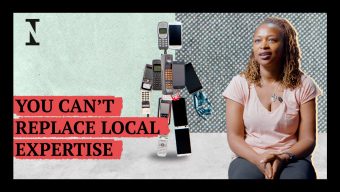The theme for International Women’s Day 2024 is “Inspire Inclusion”. It prompts us to consider how we – business, government, academia, community, and society – can collaborate to effect lasting progress that gets us to gender equity within our lifetime. By examining the intersectionality of identities and how it shapes women’s experiences of inclusion, we can recognize the value of embracing diverse perspectives. This approach not only strengthens our actions directed at gender equality but also organically fosters environments where everyone feels valued and included.
To drive meaningful change, it’s essential to understand and learn from the data and insights, to take ownership of and hold ourselves accountable for progress. Let’s commit to following the data and explore the path toward a more equitable future. According to the World Economic Forum, the global gender gap – which measures the disparity between women and men across Economic Participation and Opportunity, Educational Attainment, Health and Survival, and Political Empowerment – was at 68.6% in 2023. This is a modest 4.1% improvement since the report’s inception in 2006 across 102 countries worldwide.
At the rate that the overall global gender gap is closing, gender parity can be expected in the year 2154. That’s a long way off. To get there (and let’s aim for the immediacy this requires, shall we?) demands that we collectively advocate for policies, frameworks, and initiatives that promote equal pay, access to financial education and resources, along with advancing skills and talent development for professional, leadership, C-suite, Board, and entrepreneurship opportunities for women.
For context, women in the EU earn on average 13% less per hour than men, according to the European Commission, and only 69.3% of women are employed compared to 80% of men (EU27 data). The OECD shares further insights on women’s pensions, which are 25% lower. Globally, women currently make up 42% of the workforce – 46% at the entry levels and spiraling down to only 25% representation in the C-suite. And at that level, only 7.7% of CEOs are women, and just 7.5% of board chairs. While women’s advancement in leadership did indeed track up for the last eight years, there was a steep decline in 2022, which continued into 2023, specifically in the finance, energy, and media/entertainment industries.
Meanwhile, those sectors that are spearheading gender parity in leadership are still yet to achieve 50/50 representation, for example healthcare and education. Government is another. While women’s representation has continued to increase, parity has not been achieved: 39% of Members in the European Parliament are women. Sweden leads with the highest inclusion of female MPs at just over 47%, followed by Spain, Finland, Belgium, Austria, Denmark, Portugal, and France.
The EU’s Gender Equality Strategy 2020-2025 sets out the vision, policy objectives, and actions to make concrete progress on gender equality in Europe and towards achieving the Sustainable Development Goals. At the unveiling of the strategy in 2020, European Commission President Ursula von der Leyen stated: “In business, politics, and society as a whole, we can only reach our full potential if we use all of our talent and diversity. Using only half of the population, half of the ideas or half of the energy is not good enough.” Increasing leadership representation across all sectors is economically beneficial in addressing gender gaps in households and society.
This data story illustrates how the corporate environment continues to lag behind the progress made in legal compliance regarding intersectionality integration. While the EU has taken significant strides in inclusion through equal treatment legislation, gender mainstreaming, and the integration of the gender perspective into policies, with specific measures for the advancement of women, the corporate sector – despite compliance integration into its workplace strategy, policies, programs, and initiatives – has, quite simply, yet to catch up.
In a world where AI purports to serve the world, it is imperative to harness the intersectionality of gender equality.
To further close pay parity gaps in the corporate world, it is essential to implement thoughtful and deliberate dual mentorship, ally-ship, and tailored training programs, and to cultivate workplace environments that actively recruit, retain, and develop female talent. The onus is on our generation – now – to create inclusive workplaces where women are valued, respected, and empowered to succeed.
There are some good benchmarks already in play. For example, initiatives like Microsoft’s #BuildFor2030 and the Mastercard Foundation programs actively empower women and girls to pursue leadership positions, participate in decision-making processes, and excel in the fields of business and STEM. These models include the design and creation of infrastructure that supports elevating and empowering women and girls. Fostering inclusivity through increased participation of girls and women in STEM and ICT (Information and Communication Technology) fields is not just a moral imperative but also a strategic driver for innovation, creativity, and efficiency. The perspectives and diverse experiences brought by women are essential to creating solutions for complex, and often critical, socio-economic challenges.
There is, though, still a significant gender disparity in these fields. The Digital Economy and Society Index 2022 found that women make up only 19% of ICT specialists and one in three STEM graduates in Europe. Furthermore, the index shows that women account for only 10% of patent applicants in Europe and less than 15% of the region’s start-ups are founded or co-founded by women. And according to UNESCO, only 22% of AI professionals globally are women (and just 18% of authors at leading AI conferences are women.) In a world where AI purports to serve the world, it is imperative to harness the intersectionality of gender equality together with geographic, linguistic, and cultural diversity.
To enhance global inclusion for women and girls, advocating for inclusive infrastructure that addresses their specific needs and priorities across various settings – workplaces, academic environments, households, transportation, healthcare, and public spaces – is a necessity. Gender-responsive urban planning and development is key to creating more inclusive cities, communities, and society at large.
This is particularly critical in regions such as Africa, home to the world’s largest and growing youth population. Access to education – from financial and digital to the traditional academic – and to healthcare services, including reproductive health education as well as mental health and well-being services, forms a powerful foundational framework. These combined resources can enable women and girls to make informed and life-changing decisions, leading to positive societal impacts and increased socio-economic contributions, which in turn creates a more evolved and empowered society.
There is a unique opportunity to affect this kind of change through sport. Because of its power to unite citizens and nations at a global scale, sport has the potential to promote gender equality in that it provides women and girls the opportunities to grow social networks, build confidence, develop new skills, increase health and well-being, rally camaraderie, and transform body identity challenges through courage and resilience.
Yet, similarly to the corporate world, the sports world has more than its share of gender inequalities – from representation in C-suite and on boards’ decision-making levels to media airtime and on-field roles such as coaching and referees. Gender-based violence is also a core concern, in which women and girls frequently deal with inappropriate behavior, lack of safety, and sports facilities and resources that can potentially expose participants to physical/verbal sexual harassment and assault. Yet, even with all its difficulties, the world of sport can provide an opportunity to collectively fight for gender equality, through the establishment of general values, the advocation for equal opportunities, funding, media share of voice, and equal footing and recognition for female athletes and teams.
For the 80% of young women who participate in sport in some way or another, there are notable benefits such as increased confidence and decreased anxiety, based on data from the World Health Organization. It’s also noteworthy that 80% of female Fortune 500 executives have played competitive sports. But what is concerning is that 85% of adolescent girls are insufficiently active.
Again, the sports world is a mirror of the workforce environment regarding gender equality. Thus, collaboration and partnership with structured joint efforts are likewise key here, including from government, sponsors, sports bodies, athletes, participants, international organizations, and communities – to co-create progressive inclusion and impact that empowers women and girls.
My invitation to readers is to encourage embracing discomfort. How could you personally challenge and take ownership and accountability with the intent to harness this rapid transformation within yourself and your surroundings? Together, we must commit to co-creating a future where every individual, regardless of gender, realizes their fullest potential in contributing to a thriving, inclusive society.
© IE Insights.











